By Tony Holler
When I was a kid, track was as big as football, basketball, and baseball. From Jim Ryun to Steve Prefontaine to Edwin Moses to Bruce Jenner, track was the king of spring. Every four years, track & field was the centerpiece of the Olympic Games. Discus superstar Mac Wilkins was a sports celebrity. High jumper Dwight Stones was just as popular as NFL quarterbacks. Americans even knew foreign runners like Kichoge Keino of Kenya and Alberto Juantorena of Cuba. Track athletes made the cover of Sports Illustrated.
Then came ESPN and the proliferation of college and professional sports on television. Maybe track just doesn’t sell. Or maybe track & field was marketed by idiots. Maybe track failed to adapt and evolve. Maybe traditionalists clung to formalities and ignored track’s long slow decline. When the world learned that most professional track athletes were using PEDs or were suspected of using PEDs, no one seemed to care anymore.
Money corrupts and track was corrupted. I don’t think professional track will ever recover. Today, I am good at naming track athletes who have failed drug tests, not so good at naming superstars of the sport.
That’s why I love high school track & field. We aren’t about the money. Due to the NCAA’s revenue-driven focus on football and basketball coupled with the legalities of Title IX, men’s track scholarships are doled out as half-scholarships or less. Some universities have eliminated men’s track due to Title IX. Vanderbilt and Northwestern offer women’s track but no men’s program. When high school athletes are not scholarship-driven, they participate for the love of the sport. Many high school meets seem to consist of coaches, athletes, and a handful of parents. Spectators at high school track meets are usually bored, attending because they feel obligated to “support” their kid. I’ve seen parents travel three hours to attend a five-hour meet, just to watch their kid run a 24-second race. Track has become an insider’s game, a cult sport.
“We don’t stop playing because we grow old, we grow old because we stop playing.” – George Bernard Shaw
The key to high school track success is marketing. Not TV marketing. Not profit-based marketing. High school track must be sold to kids. Track coaches must find ways to make running fun. Track coaches must find ways to make track meets more exciting. We must think out of the box. We must think like kids. We must fight the miserable boredom of five-hour meets. Our sport can’t be governed by formal, rule-driven, stick-in-the-mud old people.
Plainfield North’s outdoor track and field facility has seen better days. Asphalt is showing everywhere. Last year our school district chose to resurface the parking lots and ignore the track at Plainfield North. Since every junior and senior in our high school seems to drive a better car than me, parking lots are a high priority. Due to our inability to host big outdoor meets, we host a 15-team indoor meet.
Our indoor track is 180 meters, nine laps to a mile. We have six lanes on the straight and four lanes on the oval. We are thankful for our indoor facility due to the harsh winter months of January, February, and March in the Chicago area. Glaciers cover our track during the first 8 weeks of our season. We don’t run an outdoor meet until April 7th. We don’t see leaves on trees until late April.
Every indoor meet on our schedule is run on a 200-meter track with FAT timing, with one exception, the one we host. In order to attract teams to our meet, we make it special. This is not a foreign concept for me. In order to attract athletes to my program, I must make my program special. I have spent my entire track & field coaching career dreaming of innovative ways to make my sport more attractive to athletes.
The @PNTRACK Invitational
First of all, note the name of our meet. Twitter is central to the promotion of my program. Now it is central to the promotion of our invitational.
I believe that all great invitationals sell t-shirts. We don’t sell t-shirts for profit, we sell for promotion.
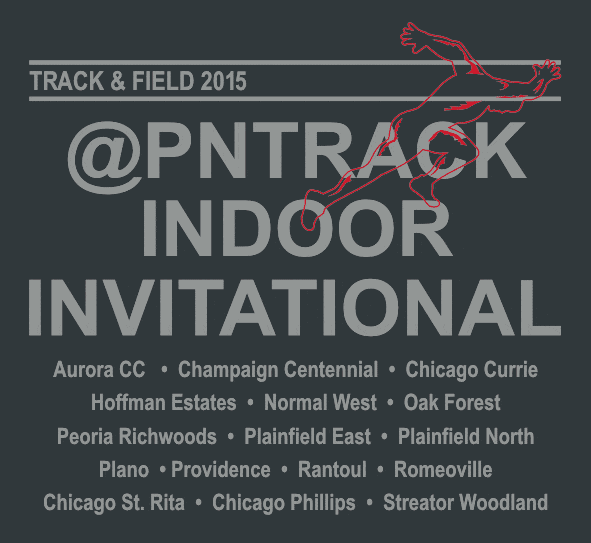
Our meet chooses not to employ FAT timing. The only two races to benefit would be the 55 meter dash and the 55 meter hurdles. All other races will not have impressive times due to the severity of the curves on a 180 meter track. Paying $1000 for two FAT races makes no sense. Instead, we take that money and feed the coaches the best BBQ in the area from our hurdle coach, John Singleton (John’s Rib House in Lisle).
We innovate by seeding races on the fly. No entries are sent into our meet. We separate the top sprinters in the prelims and run fast-heat-first in all other races. It works. Fast guys win regardless. The meet benefits because we have no breaks between races. We never have a delay. We never have small meaningless heats with lanes going unfilled. Over 1000 athletes attend our meet with 17 events, and we finish in less than five hours. This includes unlimited entries in the 55 meter dash and the 55 meter hurdles. We also run three heats of the open 1600 before the finals to allow coaches to eat their rib-tips, wings, pulled pork, and sausages.
We pay only one worker, the starter. My staff and volunteers do everything else. The money we save goes to feeding our guests.
In Illinois, captains and coaches have a required meeting with the meet manager and officials 30 minutes before the meet begins. I take this one step further. I meet with every athlete and every coach. It’s a powerful thing to stand on the judges’ platform and look out over 1000 athletes who have come to your facility on a Saturday morning. Rules are a part of the discussion, but only a small part. My major objective is to set the tone for the meet. I promote the terrific athletes who are attending our meet, and we usually have several elites. I promote the quantified nature of track & field. You may not win a gold medal, but you can set a personal record. Most of all, I attempt to set the tone for friendly competition. There is no defense in track & field. It’s all offense. We can do nothing to slow our opponents, so let’s do our best and then celebrate the winners. “Let’s make this the best meet in the state!”
Another item of significance is pre-meet music. I’m a wordy music guy who listens to lyric-based folky stuff like Bob Dylan, John Prine, James McMurtry, Chris Knight, Steve Earle, and Neil Young. However, growing up in the glorious stereo days of the 70’s inspires me to share anthem-rock whenever possible. My playlist booms through an excellent sound system in our field house. I get excited just thinking about it.
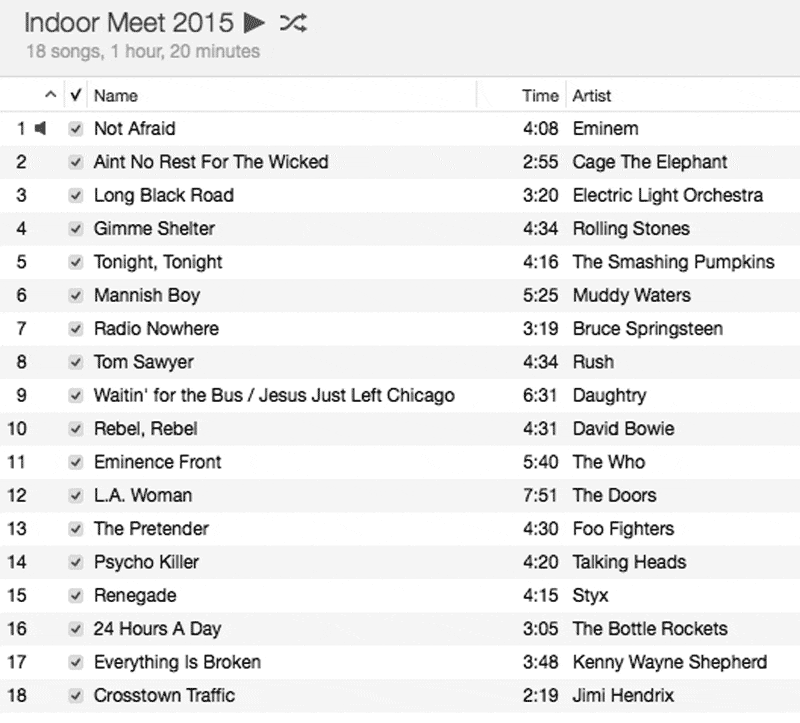
The music theme is re-established at the end of the meet. Four years ago we instituted our first special race, “Rock the 4×4”. Three heats of the 4×4 compete to loud music with teams lining the track. The three songs have not changed.
- “Seven Nation Army” by the White Stripes
- “Lose Yourself” (clean version) by Eminem
- “Zombie Nation” by Kernkraft 400
Fast Heat of Rock the 4×4
The race before the “Rock the 4×4” gets everyone up and off their feet. The top-6 shot putters run in the “Dunkin Donut 55”. The winner gets 12 donuts. One throws coach criticized me for perpetuating the stereotype of donut-eating throwers, but hey, throwers like it and the crowd loves it. In addition, the best thrower usually wins the race. At the last Saturday’s meet, Daniel Jackson of Plainfield East won the shot put throwing 53’1″ and then won the Donut-55 running an hand-held 6.67. Jackson is 6’3″ 250 and will play defensive tackle for P.J. Fleck at Western Michigan. Funny how strong, fast guys seem to play football and run track.
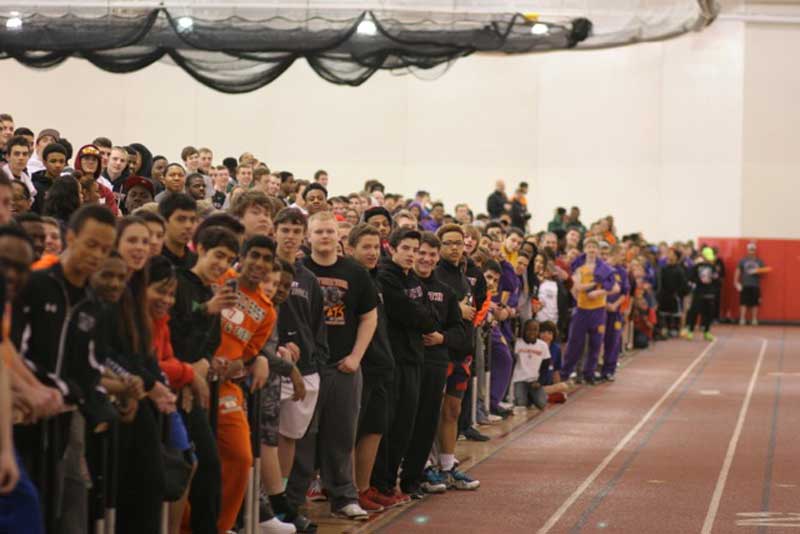
Over a thousand athletes and spectators try to get a glimpse of the Dunkin Donut 55. At the far end, you see my throws coach, Sean Carlson, holding one dozen donuts.
We considered running an exhibition “Freelap 20-Meter Fly” this year. Initially, we had interest from the six fastest sprinters from Chicago to run in this competition. However, a couple of guys backed out due to injuries, so we scrapped the event for this year.
The Gauntlet Mile
I ran sprints when I was young, but as an old man, I run longer and slower. I jogged the Chicago Marathon in 1995, 1999, 2001, and 2011. Running through crowds is a mystically energizing thing. If running through crowds energizes slow runners, what would it do for sprinters? In 2011, I began experimenting with running timed 40’s and 10-meter flys through a “gauntlet” of cheering athletes. The results were incredible. The majority of my sprinters ran personal records. This has continued to be the case every time we run the gauntlet (about three times per year). See The Gauntlet and Becoming a Zen Coach.
Last summer I saw a picture on Twitter. It looked like a distance race ran through a gauntlet. I immediately knew that the @Pntrack Invitational would feature a Gauntlet Mile in 2015.
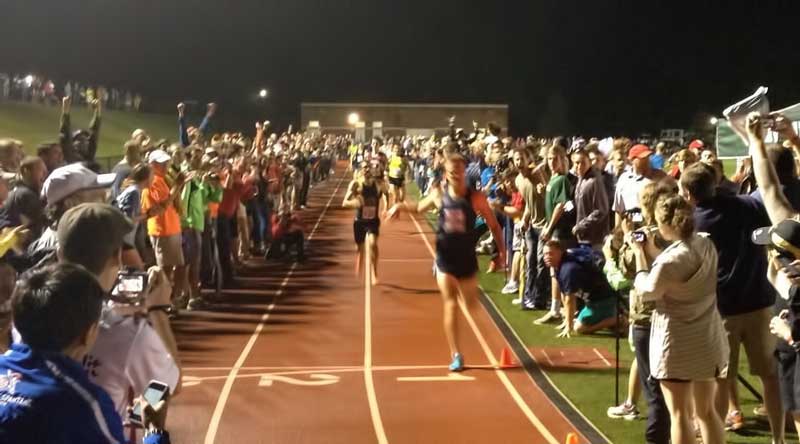
I have no idea who took this picture and posted it on twitter, but I’d be more than happy to give someone credit. I haven’t stopped thinking about it since I saw it. I want to run in this race. Who wouldn’t? In addition, I don’t think the runners are having as much fun as the spectators.
We designated the fast heat of the 1600 to be the “Gauntlet Mile”. I tried to get our Plainfield North Drum Corps to provide atmosphere, but I had to settle for a one-man band. A.J. Peal sits in the back of my 1st period Honors Chemistry class. A.J. is capable of running 4:40 in the mile this year as a sophomore and is a member of the Drum Corps. AJ set up his drum set in near the finish line and banged away for almost five minutes. The drumming reminded me of the movie “Birdman or The Unexpected Virtue of Ignorance”. People thought the drums were being amplified through the sound system, but it wasn’t. It was all A.J.
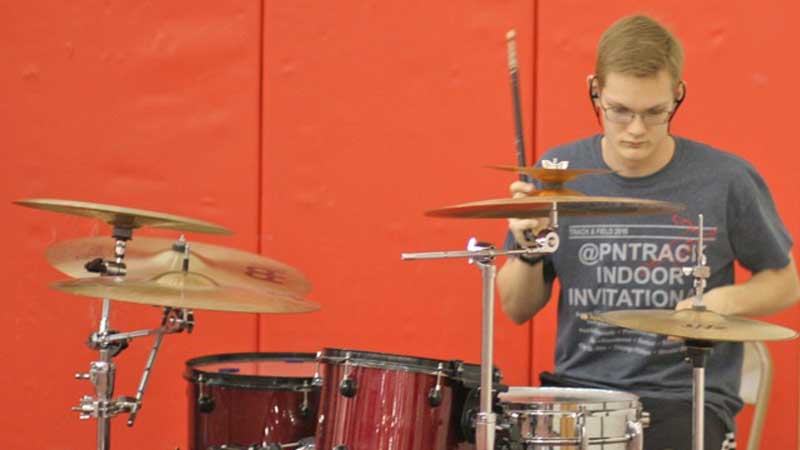
AJ Peal created a terrific atmosphere during the Gauntlet Mile.
The Gauntlet 1600 worked great. We kept the first curve clear until the runners got to the cut line. Athletes and spectators lined the entire track. Joe Suarez of Plainfield East won with a time of 4:29.6. If you are not impressed with the time, try running a 9-lap mile. Suarez will run for Notre Dame next year. North’s star junior, Jack Sebok, who ran 4:26.05 earlier this season, ran 4:33.9. However, unlike Suarez, Jack had earlier ran the 3200, running 9:48.9, breaking the meet record set in 2009 by Garrett Sweatt, now running at Stanford. Jack’s teammate, Tanner Thurman, ran a personal-best 4:38.2 to finish 3rd. The energy in the field house will never be forgotten by anyone in attendance.
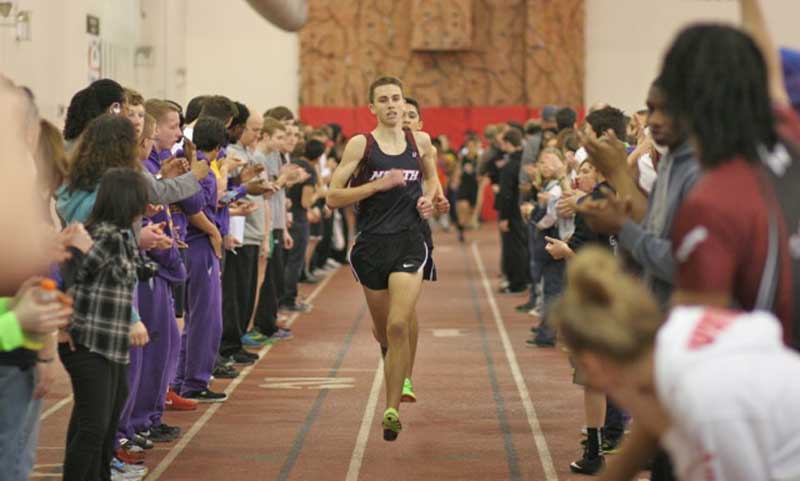
Jack Sebok of Plainfield North with the lead in the Gauntlet Mile. Joe Suarez of Plainfield East is poised to take control in the final lap of the race.
The Gauntlet Mile
Let’s just say, our final three events, the Gauntlet Mile, Dunkin Donut 55, and Rock the 4×4, sent everyone home smiling.
A Rising Tide Floats All Boats
“Enthusiasm is excitement with inspiration, motivation, and a pinch of creativity.” – Bo Bennett
Our track meet produced some great performances. Enthusiasm is very contagious. We had several elite athletes attend our meet; three of them were #1 in the state.
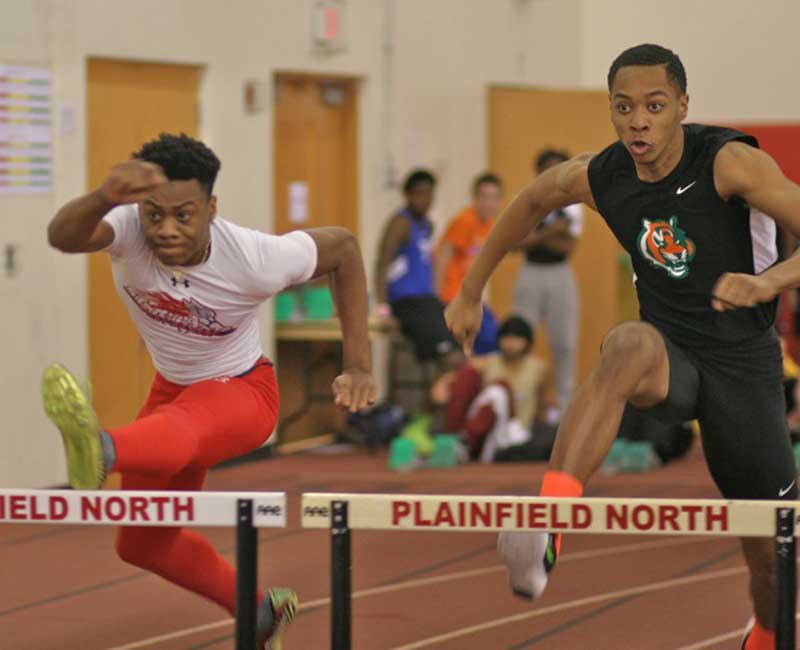
Illinois #1 hurdler, Eric Walker of St. Rita on left. Prince Smith of Plainfield East on the right.
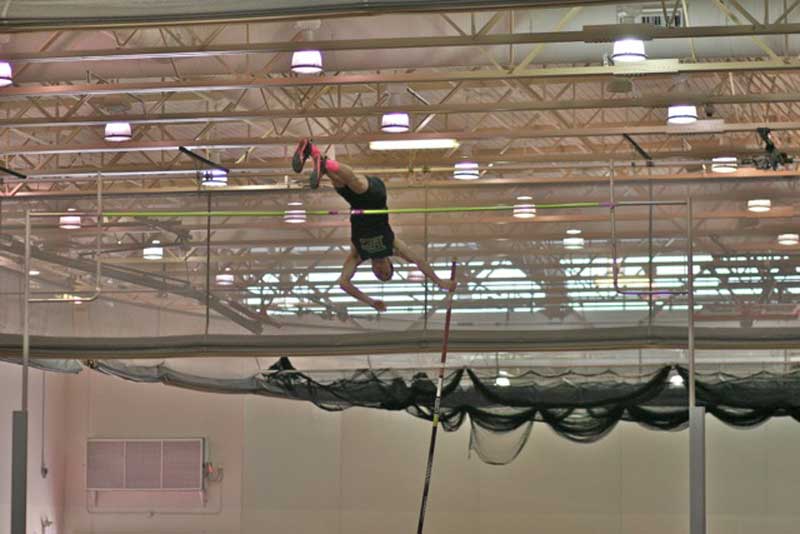
Andy Jatis of Providence Catholic is in the rafters as he sets a new meet, vaulting 15’7″. Jatis has vaulted 16’3″ already this season and expects to go over 17’0″. Jatis is considering the University of Iowa to continue vaulting.
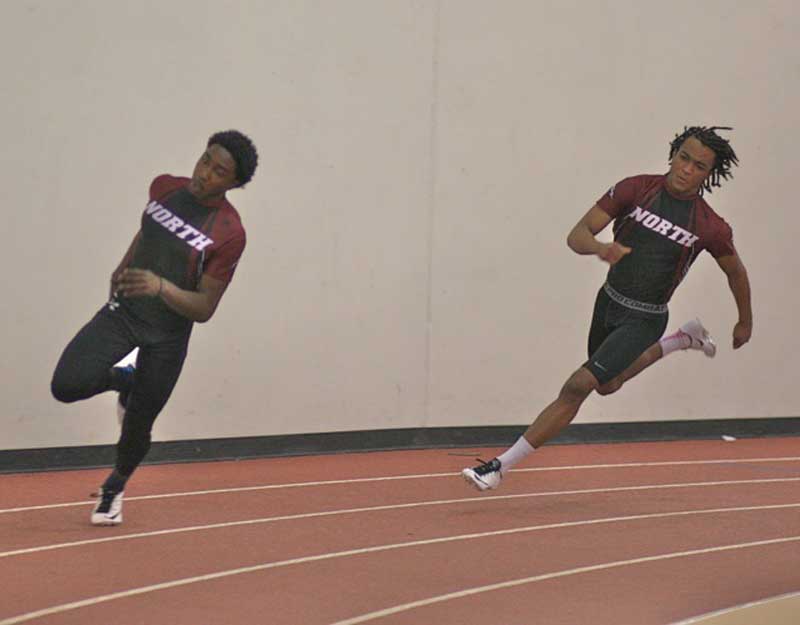
DeVaughn Hrobowski of Plainfield North (on right) set a new meet record running 22.9 on these severe curves. Hrobowski is only a junior. To his right is sophomore Carlos Baggett. Baggett split 22.6 in the 4×2 leading his team to a winning time of 1:32.7
We will never see the Gauntlet Mile at a state meet. Our state track meet needs to be a formal meet with a thick book of rules and procedures. It must be managed with calculated precision. But how about the rest of the season?
I hope some of my ideas will promote out-of-the-box thinking by others. Creative ideas are not going to come from the white-haired ex-principals who run our state associations. Innovation will come from young coaches who understand the problems facing track & field. When I speak at clinics, I shock my audience with a PowerPoint slide that simply states TRACK & FIELD SUCKS. If you proceed from the prospective that track & field sucks, maybe we can start to improve it.
Please share this article so others may benefit.
[mashshare]


Very moving, especially the Gauntlet Mile. I thought, “This is wonderful – the fans get to be part of the event by giving the runners energy close-up and personal. This is Expansive Sports at its best.” I hope many coaches will take the baton and create these wonderful experiences for young people. Track and field done like this is good for everyone – Tony is right, enthusiasm brings out the best in young people and those who love them.
A coaching friend from Indiana, Lance Vanvekoven, just sent me a text explaining the origin of the picture I used in the article.
Awesome stuff.
http://m.runnersworld.com/high-school-profiles/friday-night-lights
http://www.flashescrosstrack.com/home/flashesshowcase2014
You are the best Tony! I saw the Friday nights link and thought how cool would it be if you played the Bulls theme song or let’s get ready to rumble and turned off the lights like you were at a bulls game as you introduced the teams to start the night. I don’t know how long it would take to come into the arena. Your ideas jar me from me from being a stick in the mud dad to being a better father. thank you.